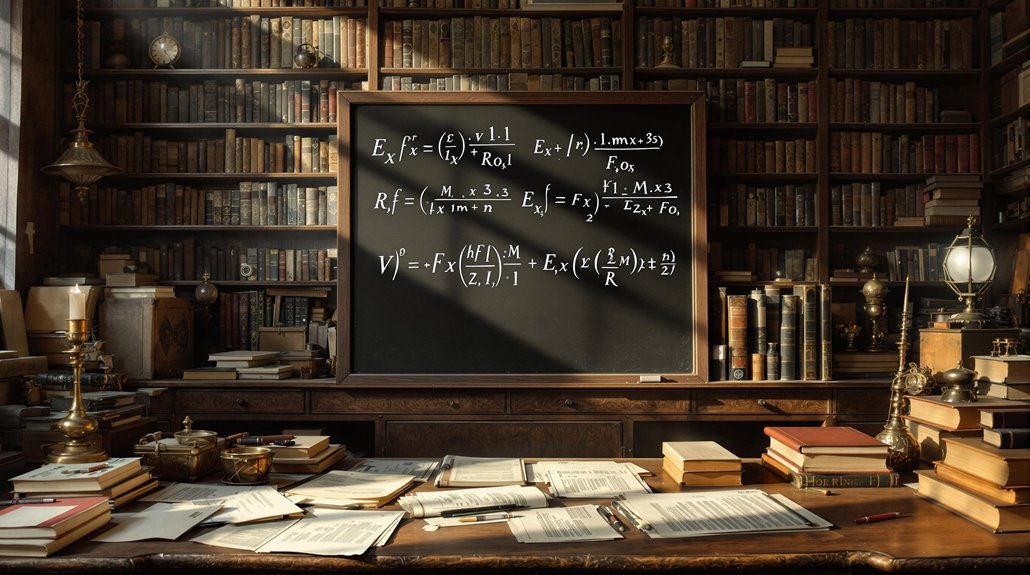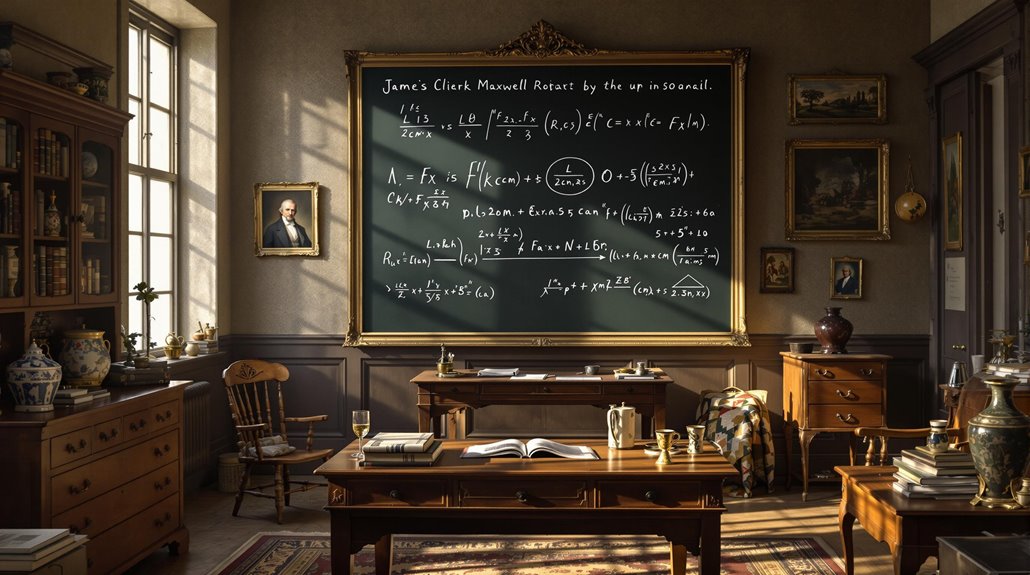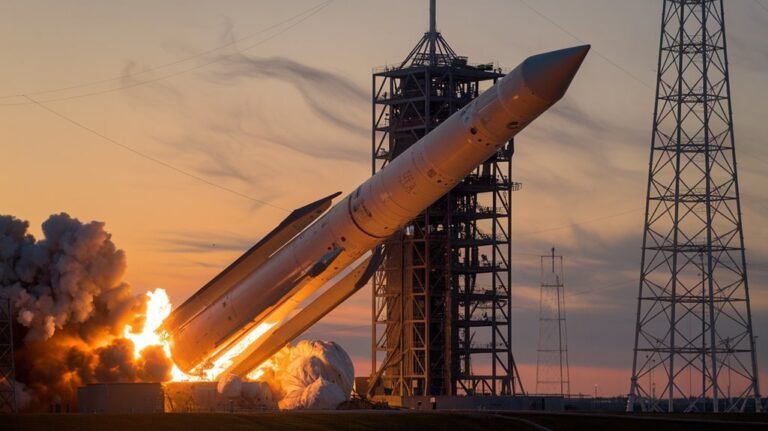James Clerk Maxwell’s Invisible Waves: The Math That Foretold Radio
Just as you're likely using wireless signals at this very moment, James Clerk Maxwell was unknowingly laying the groundwork for your modern connectivity back in the 1860s. You wouldn't have found him tinkering with antennas or building radio sets; instead, he worked with pure mathematics, scratching equations onto paper that would change our understanding of the universe. What he discovered through those mathematical formulas wasn't just groundbreaking—it was invisible to the human eye yet absolutely everywhere around us.
The Mathematical Mind Behind Electromagnetic Theory

While many scientists of his era made important discoveries through experimentation, James Clerk Maxwell's genius lay in his extraordinary mathematical abilities. From his early education at Edinburgh to his prestigious work at Cambridge, his mathematical intuition set him apart.
You'll find his brilliance reflected in winning the Smith's Prize for his work on elastic solids, a proof of his deep understanding of complex theoretical frameworks. His remarkable ability was evident when he published at age fourteen, writing his first scientific paper on oval curves and ellipses.
What made Maxwell unique was his versatility across mathematical disciplines. He didn't just master geometry and algebra; he revolutionized physics by introducing vector calculus to electromagnetism and applying statistical mechanics to molecular motion. He became the youngest professor at Marischal College in 1856, demonstrating his exceptional talent.
His use of quaternions and Lagrangian mechanics demonstrated his ability to harness advanced mathematical tools to explain natural phenomena, ultimately leading to breakthroughs that would change our understanding of the universe.
From Light to Hidden Waves: Maxwell's Revolutionary Equations
Before Maxwell's groundbreaking work, scientists viewed electricity and magnetism as separate forces governing the natural world. Through his revolutionary equations, Maxwell proved these forces were intimately connected, showing how changing electric fields create magnetic fields and vice versa. In the 19th century, he formulated four fundamental equations that completely describe electromagnetic behavior.
His mathematical insights revealed that light properties were actually electromagnetic waves traveling at an incredible speed. By unifying electricity, magnetism, and light, Maxwell predicted the existence of other invisible waves across the electromagnetic spectrum. The impact of his work was so profound that Einstein's relativity emerged from studying these equations.
You'll find his equations at work in the radio waves that carry your music, the microwaves that heat your food, and the radar systems that guide aircraft.
Hertz later confirmed Maxwell's predictions experimentally, validating one of physics' most profound theories and paving the way for modern wireless technology.
Breaking Down the Wave Prediction
Although Maxwell's equations revolutionized physics, it's his wave equation that stands as the crowning achievement of his electromagnetic theory.
When you examine the wave characteristics he predicted, you'll find that electric and magnetic fields create each other in a perpetual dance of electromagnetic propagation.
The math reveals something remarkable: these waves don't need a medium to travel through space.
Maxwell's equation, ∇²E = (1/c²) ∂²E/∂t², shows that electromagnetic waves move at the speed of light, with electric and magnetic fields oscillating perpendicular to each other.
Using vector calculus and the constants of permittivity and permeability, he proved that waves could carry energy through a vacuum at approximately 3 × 10⁸ meters per second.
Michael Faraday's discovery of magnetic lines of force provided the foundational insight that Maxwell would later translate into mathematical equations.
This groundbreaking prediction unified electricity, magnetism, and optics while challenging the prevailing aether theory. Heinrich Hertz later confirmed Maxwell's theoretical work when he generated electromagnetic waves in his laboratory experiments.
The Journey From Theory to Experimental Proof
Maxwell's brilliant mathematical predictions needed tangible proof to convince the skeptical scientific community.
The theoretical implications of his work challenged the prevailing understanding of how energy moved through space, creating experimental challenges for scientists attempting verification.
Lord Kelvin's resistance to accepting the theory without mechanical models highlighted the broader scientific community's struggle with its abstract nature.
Building on his earlier work at Kings College London, Maxwell published two groundbreaking papers on electromagnetic field theory that would shape modern physics.
Twenty-two years after Maxwell's predictions, Heinrich Hertz finally demonstrated what Maxwell had envisioned through his groundbreaking experiments.
Using his ingenious spark-gap apparatus, Hertz proved that:
- Electromagnetic waves could travel through space
- These waves moved at the speed of light
- They could be generated and detected
- They behaved similarly to visible light
This experimental validation transformed Maxwell's abstract mathematics into physical reality, bridging the gap between theory and observation.
Hertz's success not only validated Maxwell's work but also laid the foundation for the wireless technologies you use today.
Unleashing a New Era of Communication

The revolution in wireless communication began with a single milestone: KDKA's first commercial broadcast in 1920.
You'd be amazed at how quickly this communication revolution spread – from just 1% of U.S. households owning radios in 1923 to an overwhelming majority by 1931.
The radio evolution transformed society in ways no one could have predicted. Within two decades, it reached nearly 80% of Americans, becoming the first electronic mass medium. This technology's foundation was laid by Maxwell's groundbreaking electromagnetic field theory published in 1865.
The U.S. Navy led early advancements with their station NAA in Arlington broadcasting daily time signals and weather reports in 1913.
You could see its impact most dramatically during World War II, when audience numbers jumped from 18% during peacetime to 58% during the conflict.
 largely unrecognized outside scientific circles during his lifetime. His influence extends far beyond his famous equations, touching nearly every aspect of modern physics.
largely unrecognized outside scientific circles during his lifetime. His influence extends far beyond his famous equations, touching nearly every aspect of modern physics.
His legacy includes:
- Establishing foundations for both relativity and quantum mechanics
- Ranking as the third greatest physicist in history, behind only Newton and Einstein
- Contributing to kinetic theory of gases with the Maxwell-Boltzmann distribution
- Pioneering work in color photography and Saturn's rings analysis
Einstein himself acknowledged Maxwell's work as the most profound since Newton.
You're experiencing his legacy every time you use wireless technology, as his mathematical predictions of electromagnetic waves made modern communications possible.










